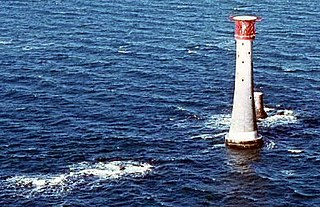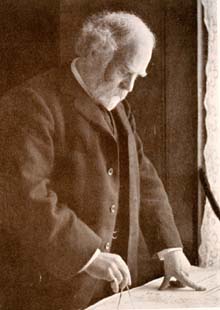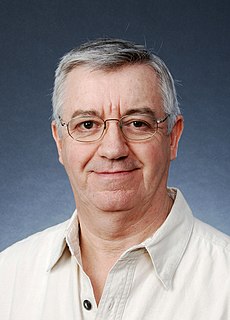Related Research Articles

Marine biology is the scientific study of the biology of marine life, organisms in the sea. Given that in biology many phyla, families and genera have some species that live in the sea and others that live on land, marine biology classifies species based on the environment rather than on taxonomy.

Oceanography, also known as oceanology, is the scientific study of the oceans. It is an important Earth science, which covers a wide range of topics, including ecosystem dynamics; ocean currents, waves, and geophysical fluid dynamics; plate tectonics and the geology of the sea floor; and fluxes of various chemical substances and physical properties within the ocean and across its boundaries. These diverse topics reflect multiple disciplines that oceanographers utilize to glean further knowledge of the world ocean, including astronomy, biology, chemistry, climatology, geography, geology, hydrology, meteorology and physics. Paleoceanography studies the history of the oceans in the geologic past. An oceanographer is a person who studies many matters concerned with oceans including marine geology, physics, chemistry and biology.

Harald Ulrik Sverdrup was a Norwegian oceanographer and meteorologist. He was director of Scripps Institution of Oceanography and director of the Norwegian Polar Institute.

Hydrography is the branch of applied sciences which deals with the measurement and description of the physical features of oceans, seas, coastal areas, lakes and rivers, as well as with the prediction of their change over time, for the primary purpose of safety of navigation and in support of all other marine activities, including economic development, security and defense, scientific research, and environmental protection.

The Eddystone or Eddystone Rocks are a seaswept and eroded group of rocks ranging 9 miles (14 km) southwest of Rame Head in Cornwall, United Kingdom. Although the nearest point on the mainland to the Eddystone is in Cornwall, the rocks fall within the city limits of Plymouth, and hence within the county of Devon.

A research vessel is a ship or boat designed, modified, or equipped to carry out research at sea. Research vessels carry out a number of roles. Some of these roles can be combined into a single vessel but others require a dedicated vessel. Due to the demanding nature of the work, research vessels are often constructed around an icebreaker hull, allowing them to operate in polar waters.

Sir John Murray was a pioneering Canadian-born British oceanographer, marine biologist and limnologist. He is considered to be the father of modern oceanography.
Plymouth Marine Laboratory in the city of Plymouth, England, is a marine research organization and registered charity. It is a partner of the UK Research & Innovation's Natural Environment Research Council (NERC). PML's chair is Janice Timberlake, its chief executive is Prof. Icarus Allen and its patron is the film-maker James Cameron.

Martin Hans Christian Knudsen was a Danish physicist who taught and conducted research at the Technical University of Denmark.
The Alexander Agassiz Medal is awarded every three years by the U.S. National Academy of Sciences for an original contribution in the science of oceanography. It was established in 1911 by Sir John Murray in honor of his friend, the scientist Alexander Agassiz.
The sixgill sharks are a genus, Hexanchus, of deepwater sharks in the family Hexanchidae. These sharks are characterized by a broad, pointed head, six pairs of gill slits, comb-like, yellow lower teeth, and a long tail. The largest species can grow up to 8 m long and weigh over 600 kg (1320 lb). They are continental shelf-dwelling and abyssal plain scavengers with a keen sense of smell and are among the first to arrive at carrion, together with hagfish and rattails. They show a characteristic rolling motion of the head when feeding.
The Naval Oceanographic Office (NAVOCEANO), located at John C. Stennis Space Center in south Mississippi, comprises approximately 1,000 civilian, military and contract personnel responsible for providing oceanographic products and services to all elements within the Department of Defense.
Martin Wiggo Johnson, was an American oceanographer at Scripps Institution of Oceanography. He is known as an author of the landmark reference work The Oceans: Their Physics, Chemistry and General Biology ; for explaining the deep scattering layer (DSL) as a result of what is now called the diel vertical migration; and for studies of zooplankton that revealed that the physics of water movement was an important influence on population biology and community diversity.

The sea surface microlayer (SML) is the boundary interface between the atmosphere and ocean, covering about 70% of the Earth's surface. With an operationally defined thickness between 1 and 1000 µm, the SML has physicochemical and biological properties that are measurably distinct from underlying waters. Recent studies now indicate that the SML covers the ocean to a significant extent, and evidence shows that it is an aggregate-enriched biofilm environment with distinct microbial communities. Because of its unique position at the air-sea interface, the SML is central to a range of global biogeochemical and climate-related processes.
Edward David Goldberg was a marine chemist, known for his studies of pollution in the oceans.

The Continuous Plankton Recorder (CPR) Survey is one of the longest running marine biological monitoring programmes in the world. Started in 1931 by Sir Alister Hardy and Sir Cyril Lucas, the Survey provides marine scientists and policy-makers with measures of plankton communities, coupled with ocean physical, biological and chemical observations, on a pan-oceanic scale. The Survey is a globally recognised leader on the impacts of environmental change on the health of our oceans.

The Marine Biological Association of the United Kingdom (MBA) is a learned society with a scientific laboratory that undertakes research in marine biology. The organisation was founded in 1884 and has been based in Plymouth since the Citadel Hill Laboratory was opened on 30 June 1888.

Michael John Robert Fasham, FRS was a British oceanographer and ecosystem modeller. He is best known for his pioneering work in the development of open ocean plankton ecosystem models.

RV Huxley was the first research vessel used by the Marine Biological Association of the United Kingdom explicitly for fisheries research and is regarded as the first vessel yielding data for the Ministry of Agriculture, Fisheries and Food - Directorate of Fisheries, now known as the Centre for Environment, Fisheries and Aquaculture Science (Cefas).

Trevor Charles Platt was a British and Canadian biological oceanographer who was distinguished for his fundamental contributions to quantifying primary production by phytoplankton at various scales of space and time in the ocean.
References
- 1 2 3 Cooper, L. H. N. (1972). "Hildebrand Wolfe Harvey 1887-1970". Biographical Memoirs of Fellows of the Royal Society . 18: 330–347. doi: 10.1098/rsbm.1972.0011 .
- ↑ L.H.N. Cooper (2004). "Harvey, Hildebrand Wolfe". Oxford Dictionary of National Biography (online ed.). Oxford University Press. doi:10.1093/ref:odnb/33747.(Subscription or UK public library membership required.)
- ↑ Biological Oceanography: an early history 1870-1960 by E.L. Mills (Cornell University Press, 1989)
- ↑ "Alexander Agassiz Medal". Archived from the original on 29 June 2010. Retrieved 9 May 2007.
- ↑ The H. W. Heape papers in the MBA Archive Collection: http://www.mba.ac.uk/NMBL/archives/archives_personal/personal_papers.htm#harvey Archived 13 July 2012 at the Wayback Machine
- ↑ Cooper, L. H. N. (2009). "Hildebrand Wolfe Harvey". Journal of the Marine Biological Association of the United Kingdom. 52 (3): 773–775. doi: 10.1017/S0025315400021706 .
- ↑ Harvey, H. W. (2009). "On the production of living matter in the sea off Plymouth" (PDF). Journal of the Marine Biological Association of the United Kingdom. 29: 97–137. doi:10.1017/S002531540005623X.
- ↑ "Library and Archive Catalogue". London: The Royal Society. Retrieved 11 November 2013.